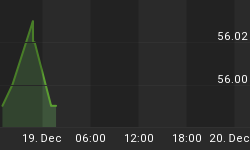Either the strategy of releasing downgrade announcements for Europe at 4:30 ET paid off, or sovereign ratings have become largely irrelevant. On Monday, albeit a market holiday in the U.S., bond markets ignored the downgrades and equity markets rallied in the U.S. (via futures) and in Europe.
Except for Portugal. Portuguese 5-year note yields rose 193bps to 16.13%; 10-year note yields rose 125bps to 13.17% (see Chart, source Bloomberg).

Portugal seems to be saying 'we got next.'
Why Portugal? Why not Spain, or France? It's understandable why Greece, which everyone already assumes will default, didn't sell off further; Portugal, it seems, is considered next in line. I still would have expected the other countries in the queue to have moved up as well, since they are getting closer to the front of the line (and,as I said on Saturday, there is always a chance that the dominos all fall at once in a big unzipping).
Volumes were lighter, of course, with most U.S. traders out for the day, and we may see more of a reaction on Tuesday, but honestly I don't expect much of one. We did get a tiny bit of additional information on Monday, and that was that the European Financial Stability Facility (EFSF) also, unsurprisingly, had its rating cut from AAA to AA+ as a direct consequence of the downgrading of many of the constituent members. This downgrading happened even though the EFSF is technically ultimately backstopped by only the AAA members...the problem is that those AAA guarantees are only worth €271bln now rather than €451bln. There will be an immediate test of the new rating, although a mild one, as the EFSF goes to market tomorrow to sell 6-month bills (because, you know, 3 months might not be enough to completely solve the crisis I guess).
Speaking of tests of a rating, here's your scary chart of the day. Looking back to the U.S., where Treasury yields are below expected inflation for 10 years, the distribution of US debt looks like this:

Ouch! The employees of the Treasury are certainly earning their pay these days.
Yes, that's $2.7 trillion the Treasury needs to roll this year, not including the new money to cover this year's deficit. About $1.9 trillion of that is in the first half of the year ($1.3 trillion of which are Treasury Bills). I sure hope we can keep rolling a trillion or so T-Bills every quarter! What could go wrong?
Now, the Treasury had a similar, if somewhat smaller, problem last year. But last year, the Federal Reserve was generously vacuuming up hundreds of billions of dollars of the issuance. Right now, investors fleeing Europe are filling in for the Fed. What happens if the crisis in Europe really does recede?
All of these things are hopelessly intertwined. Like two trees which have grown together, the banking and sovereign crises in both Europe and the U.S. may have become inseparable - saving one may imply killing the other. It may be that only way that the U.S. can fund itself is if money continues to flee Europe!
The Treasury will sell $56bln in T-Bills tomorrow, and $15bln in new 10-year TIPS on Thursday. There shouldn't be any problem with these auctions, yet. Empire Manufacturing (Consensus: 11.00 from 9.53) for January is also due out, along with revisions, but shouldn't move markets. We will instead react carefully to news out of Europe, and more particularly our markets will respond on the basis of howtheirmarkets are responding. The reviews from Monday suggest our bonds could lose some flight-to-quality sponsorship, but it's early yet.
















